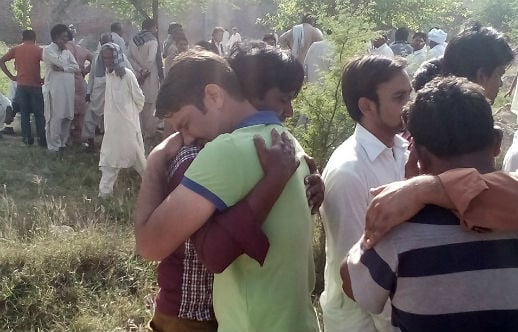Pakistan Christians bury their dead after Easter massacre

Mourners at Lahore funeral
Parvaiz Masih didn’t know his son was among the hundreds injured in the Easter bombing of a crowded park until the boy had arrived at the hospital.
“I don’t know when Waqar left and went to the park with friends,” said the 16-year-old boy’s father. Hundreds of people, including many Christians, were at Gulshan-e-Iqbal Park, the largest in Lahore, enjoying the warm Easter weather.
A bomb explosion killed scores of people on the spot. Hundreds more were taken to hospitals.
“After he got injured he was taken up to Sheikh Zahid Hospital, from where he was shifted to the Mayo Hospital, but he succumbed to his injuries,” Masih told World Watch Monitor.
“Waqar was a Class-9 student at St. John’s School, Youhanabad,” the father said. “He dreamt of growing up and serving his country and the community.”
The bomb killed at least 74 people and injured more than 300. A later report says only 60 remain in hospital.
Their funeral, he said, was attended by parliamentarians, including Punjab Assembly member Shunila Ruth; Ports and Shipping Minister Senator Kamran Michael; and the Anglican Bishop of Raiwind, Azad Marshall.
One mourner reflected: “When you have seen death – you have seen children fly into their air whole, and fall back on the earth in slivers and pieces – what have you got to fear? Something fills you with the knowledge that if you lived through that, you will live through anything God wants you to. And will die from anything God wants to use to take you. I don’t know why God gave me life. I would rather die. I am not afraid, just desperately confused.”
Another mourner added: “Their father’s hand was on one coffin. As photographers crowded around, he screamed: ‘You will not show him to the world this way!’ – because his son’s face was mutilated beyond belief. He kept repeating over and over again: ‘My son died on the rides. He was on the rides. He was on the rides. It was on the rides’.
“People tried to move away a little boy curled up by the coffin, and to tell him to let them put it in the ground. People were spent from tears and crying, and yet found some energy to dig the graves of their loved ones. The little boy would not let go and wept. I asked the family to let him hold the coffin a little more, and then he looked at me, and we locked eyes before he said, ‘He was my brother after all’.”
Directly after the Lahore suicide blast, army chief Raheel Sharif ordered intelligence agencies to track down those responsible. “We must bring the killers of our innocent brothers, sisters and children to justice and will never allow these savage inhumans (sic) to overrun our life and liberty,” Sharif was quoted as saying by the Pakistan satellite news channel, Samaa.
In the subsequent 48 hours, at least 5,221 suspects were arrested, Pakistan Today reported. A long-awaited crackdown on banned organisations in the Punjab has begun. Security agencies identified the suicide bomber as a man named Yousuf, and arrested his brothers in southern Punjab.
As the country reeled from the Easter massacre, the Pakistan Army was dispatched the same day to the capital, Islamabad, to stop the advance of more than a thousand protesters into the diplomatic sector of the city, the so-called ‘red zone’. The protests continued into Wednesday 30 Marc in support of Mumtaz Qadri, who was executed on 29 Feb. for killing the Governor of Punjab, Salmaan Taseer. Qadri had defended his 2011 assassination on the grounds that Taseer had advocated reforms in Pakistan’s anti-blasphemy law, and that Taseer supported the release of Aasiya Noreen (more commonly known as “Asia Bibi”), a Christian woman condemned to death for blasphemy.
The protesters beat police and burned vehicles and buildings.
They presented a 10-point demand which included: “the unconditional release of all Sunni clerics and leaders booked on various charges, including terrorism and murder; the recognition of Mumtaz Qadri as a martyr and the conversion of his Adiala Jail cell into a national heritage site; assurances that the blasphemy laws will not be amended …and the execution of blasphemy accused Asia Bibi.”
World Watch Monitor report used by permission.
Email This Story
Why not send this to a friend?


